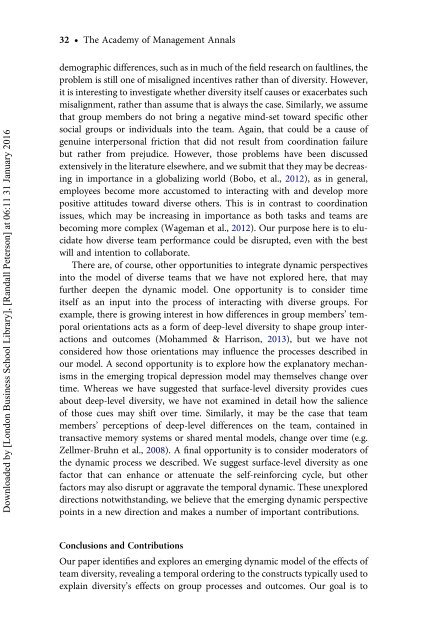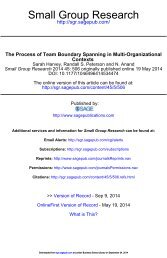A Dynamic Perspective on Diverse Teams: Moving From The Dual Process Model to A Dynamic Coordination-Based Model of Diverse Team Performance - Kannan Srikanth, Sarah Harvey & Randall Peterson
The existing literature on diverse teams suggests that diversity is both helpful to teams in making more information available and encouraging creativity and damaging to teams in reducing cohesion and information sharing. Thus the extant literature suggests that diversity within teams is a double-edged sword that leads to both positive and negative effects simultaneously.
The existing literature on diverse teams suggests that diversity is both helpful to teams in making more information available and encouraging creativity and
damaging to teams in reducing cohesion and information sharing. Thus the
extant literature suggests that diversity within teams is a double-edged sword
that leads to both positive and negative effects simultaneously.
Create successful ePaper yourself
Turn your PDF publications into a flip-book with our unique Google optimized e-Paper software.
32 † <strong>The</strong> Academy <strong>of</strong> Management Annals<br />
Downloaded by [L<strong>on</strong>d<strong>on</strong> Business School Library], [<strong>Randall</strong> Peters<strong>on</strong>] at 06:11 31 January 2016<br />
demographic differences, such as in much <strong>of</strong> the field research <strong>on</strong> faultlines, the<br />
problem is still <strong>on</strong>e <strong>of</strong> misaligned incentives rather than <strong>of</strong> diversity. However,<br />
it is interesting <strong>to</strong> investigate whether diversity itself causes or exacerbates such<br />
misalignment, rather than assume that is always the case. Similarly, we assume<br />
that group members do not bring a negative mind-set <strong>to</strong>ward specific other<br />
social groups or individuals in<strong>to</strong> the team. Again, that could be a cause <strong>of</strong><br />
genuine interpers<strong>on</strong>al fricti<strong>on</strong> that did not result from coordinati<strong>on</strong> failure<br />
but rather from prejudice. However, those problems have been discussed<br />
extensively in the literature elsewhere, and we submit that they may be decreasing<br />
in importance in a globalizing world (Bobo, et al., 2012), as in general,<br />
employees become more accus<strong>to</strong>med <strong>to</strong> interacting with and develop more<br />
positive attitudes <strong>to</strong>ward diverse others. This is in c<strong>on</strong>trast <strong>to</strong> coordinati<strong>on</strong><br />
issues, which may be increasing in importance as both tasks and teams are<br />
becoming more complex (Wageman et al., 2012). Our purpose here is <strong>to</strong> elucidate<br />
how diverse team performance could be disrupted, even with the best<br />
will and intenti<strong>on</strong> <strong>to</strong> collaborate.<br />
<strong>The</strong>re are, <strong>of</strong> course, other opportunities <strong>to</strong> integrate dynamic perspectives<br />
in<strong>to</strong> the model <strong>of</strong> diverse teams that we have not explored here, that may<br />
further deepen the dynamic model. One opportunity is <strong>to</strong> c<strong>on</strong>sider time<br />
itself as an input in<strong>to</strong> the process <strong>of</strong> interacting with diverse groups. For<br />
example, there is growing interest in how differences in group members’ temporal<br />
orientati<strong>on</strong>s acts as a form <strong>of</strong> deep-level diversity <strong>to</strong> shape group interacti<strong>on</strong>s<br />
and outcomes (Mohammed & Harris<strong>on</strong>, 2013), but we have not<br />
c<strong>on</strong>sidered how those orientati<strong>on</strong>s may influence the processes described in<br />
our model. A sec<strong>on</strong>d opportunity is <strong>to</strong> explore how the explana<strong>to</strong>ry mechanisms<br />
in the emerging tropical depressi<strong>on</strong> model may themselves change over<br />
time. Whereas we have suggested that surface-level diversity provides cues<br />
about deep-level diversity, we have not examined in detail how the salience<br />
<strong>of</strong> those cues may shift over time. Similarly, it may be the case that team<br />
members’ percepti<strong>on</strong>s <strong>of</strong> deep-level differences <strong>on</strong> the team, c<strong>on</strong>tained in<br />
transactive memory systems or shared mental models, change over time (e.g.<br />
Zellmer-Bruhn et al., 2008). A final opportunity is <strong>to</strong> c<strong>on</strong>sider modera<strong>to</strong>rs <strong>of</strong><br />
the dynamic process we described. We suggest surface-level diversity as <strong>on</strong>e<br />
fac<strong>to</strong>r that can enhance or attenuate the self-reinforcing cycle, but other<br />
fac<strong>to</strong>rs may also disrupt or aggravate the temporal dynamic. <strong>The</strong>se unexplored<br />
directi<strong>on</strong>s notwithstanding, we believe that the emerging dynamic perspective<br />
points in a new directi<strong>on</strong> and makes a number <strong>of</strong> important c<strong>on</strong>tributi<strong>on</strong>s.<br />
C<strong>on</strong>clusi<strong>on</strong>s and C<strong>on</strong>tributi<strong>on</strong>s<br />
Our paper identifies and explores an emerging dynamic model <strong>of</strong> the effects <strong>of</strong><br />
team diversity, revealing a temporal ordering <strong>to</strong> the c<strong>on</strong>structs typically used <strong>to</strong><br />
explain diversity’s effects <strong>on</strong> group processes and outcomes. Our goal is <strong>to</strong>
















